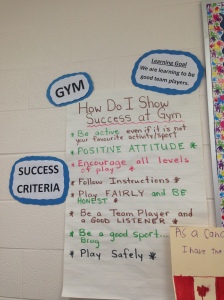Today I spent some time at Roger Neilson Public School, Peterborough. It is a relatively small school, with approximately one class of students per year level, although kindergarten enrolments are on the increase. I was greeted by Tony, the School Principal, who was pleased to show me around his school, and talk about restorative practices in his setting. He has been in the school for three years now, and purposely encouraged his teachers to adopt circles as a restorative platform, particularly for building positive relationships and solving problems effectively. Tony said that when he started at Roger Neilson his first impression of his office was that there were a LOT of chairs lined up against the wall adjacent his door. He asked, “who are all these chairs for?” They were there for the students regularly being sent out of class. Tony’s philosophy was that “these chairs should be in the classrooms, not in the office” as problems are best solved with the people most involved, the student’s themselves – in their community with their teacher. With / Not To. And since circles have become embedded in the school culture, student ‘exclusions’ to the office have decreased significantly – which provides Tony with more time to “get ahead – not fall behind”. I was impressed that he knew every single student by name, and was able to tell me a little bit about them as we crossed paths.
Every day of the week most classrooms begin with a circle. It is a bit like a ‘check-in’ with the students, to connect them with each other and share thoughts, feelings and experiences. Today, Ms Barry and her Year 5 classroom welcomed me into their circle and allowed me to ask some questions. Using the circle as a platform we discussed what the students like most about circles, and how they use them to solve problems. They told me how the circle gives them a chance to get things off their minds, and share things that have happened to them. This then helps them to concentrate in class. They also told me how they can have a circle if there has been a problem in the yard and use this forum to get support from each other, or ideas to help them with the problem. Ms Barry reminds the children how important it is to try to “step into someone else’s shoes” and imagine how things feel for others – the basis of empathy. She also asks the students “how full is your tray today?” This helps them to identify how stressed they are feeling and if they need some time or support to “empty their tray”. Ms Barry explained that this also helps the other students to recognise when someone is at the limit of their emotional capacity, and may need some space.
Other teachers extend their circle content to include a brief summary of the day’s activities to keep the students informed. They are also linked to curriculum outcomes.
The students attending Roger Neilson are mostly from low socio-economic backgrounds, and are faced with much adversity. The school provides a breakfast program that is very popular. But every day the students partake in a circle in which they are reminded that they are not alone, that they can support each other and look out for each other. By sharing their experiences and helping each other solve problems they are compassionately witnessing each other, developing empathy and connectedness.
School Principal, Tony, explained that he prefers not to think of restorative practice being used to respond to problems. But rather, it is a pro-active and preventative model that has contributed to the safe, caring, learning environment at Roger Neilson.
Ms Barry said that she had implemented circles for many years, but it was only recently when Mr Stan Baker (the District’s Safe, Caring and Restorative Schools Resource Teacher) spoke to the staff about restorative practices that she recognised the underlying values in what she was doing. This has enabled her to extend her knowledge and use of circles whilst being more mindful of what she is actually achieving within her classroom.
At Roger Neilson Public School I observed the following restorative principles : student voice, with/not to, community, witnessing, support, responsibility, accountability, respect, safety, compassion



